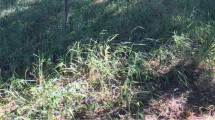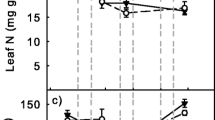Abstract
The decline of riparian Eucalyptus camphora/E. ovata stands is examined in relation to an increase in nitrogen availability and to rising salinity in low-lying areas. There are several indications that declining stands are abnormally rich in N: (i) Nitrogen availability in declining stands was greater than that recorded in other Australian forests, was dominated by nitrification and was extremely variable. (ii) Nitrate concentrations in free soil water from declining forest on a dry site were many times those in the corresponding healthy forest. (iii) N/Mg ratios in foliage of declining trees on drier sites were at the extreme end of the recorded range and similar to those found in eucalypt plantations on agricultural soils. In addition, sites where the overstorey eucalypts are declining have been invaded by a variety of herbaceous weeds, most of which display characteristics of nitrophilous plants, e.g. nitrate reductase activity was greater in herbaceous weeds than in native overstorey or understory species in declining stands of E. camphora/E. ovata and was directly related to the concentration of nitrogen in foliage. These observations are consistent with recent suggestions that forest ecosystems may become N-saturated.
Similar content being viewed by others
References
Aber JD (1992) Nitrogen cycling and nitrogen saturation in temperate forest ecosystems. Trends Ecol Evol 7:220–224
Adams MA, Atkinson PI (1991) Nitrogen supply and insect herbivory in eucalypts: the role of nitrogen assimilation and transport processes. In: Ryan PJ (ed) Productivity in perspective. (Proc Third Aust For Soils and Nutr Conf.) Forestry Commission of NSW, Syndney, pp 67–75
Adams MA, Attiwill PM (1982a) Nitrogen mineralization and nitrate reduction in forests. Soil Biol Biochem 14: 197–202
Adams MA, Attiwill PM (1982b) Nitrate reductase activity and growth response of forest species to ammonium and nitrate sources of nitrogen. Plant Soil 66:373–381
Adams MA, Attiwill PM (1986) Nutrient cycling and nitrogen mineralization in eucalypt forests of south-eastern Australia. II. Indices of nitrogen mineralization. Plant Soil 92: 341–362
Adams MA, Attiwill PM (1991) Nutrient balance in forests of northern Tasmania. I. Atmospheric inputs and within-stand cycles. For Ecol Manage 44:93–113
Adams MA, Attiwill PM, Polglase PJ (1989) Availability of nitrogen and phosphorus in forest soils in northeastern Tasmania. Biol Fert Soils 8:212–218
Attiwill PM, Leeper GW (1987) Forest soils and nutrient cycles. Melbourne University Press, Melbourne
Baker TG, Attiwill PM (1987) Fluxes of elements in rain passing through forest canopies in south-eastern Australia. Biogeochem 4:27–39
Crombie DS, Milburn JA (1988) Water relations of rural eucalypt dieback. Aust J Bot 36:233–237
Ellenberg H (1987) Floristic changes due to eutrophication. In: Asman WAH, Diederen SMA (eds) Ammonia and acidification (Proc EUROSAP Symp, Bilthoven, The Netherlands). pp 301–505
Falkengren-Grerup U (1986) Soil acidification and vegetation changes in deciduous forest in southern Sweden. Oecologia 70:339–347
Greenfelt P, Hultberg H (1986) Effects of nitrogen deposition on the acidification of terrestrial and aquatic ecosystems. Water Air Soil Pollut 30:945–963
Gebauer G, Rehder H, Wollenweber B (1988) Nitrate, nitrate reduction and organic nitrogen in plants from different ecological and taxonomic groups of Central Europe. Oecologia 75: 371–385
Hageman RH, Reed AJ, Femmer RA, Sherrard JH, Dalling MJ (1980) Some new aspects of the in vivo assay for nitrate reductase in wheat. Plant Physiol 65:27–32
Heatwole H, Lowman M (1986) Dieback: death of an Australian landscape. Reed Books P/L, New South Wales
Högbom L, Högberg P (1991) Nitrate nutrition of Deschampsia flexuosa (L.) Trin. in relation to nitrogen deposition in Sweden. Oecologia 87:488–494
Högbom L, Ohlson M (1991) Nitrate assimilation in coexisting vascular plants in mire and swamp forest habitats in Central Sweden. Oecologia 87:495–499
Judd TS, Attiwill PM, Adams MA (1991) Foliar diagnosis of Eucalyptus globulus and E. nitens plantations in southeastern Australia. In: Ryan PJ (ed) Productivity in perspective. (Proc Third Aust For Soils and Nutr Conf.) Forestry Commission of NSW, Sydney, pp 162–163
Kazda M (1990) Indications of unbalanced nitrogen nutrition of Norway spruce stands. Plant Soil 128:97–101
Landsberg J (1985) Drought and dieback of rural eucalypts. Aust J Ecol 10:87–90
Landsberg J, Wylie FR (1983) Water stress, leaf nutrients and defoliation: a model of dieback of rural eucalypts. Aust J Ecol 8: 27–41
Landsberg J, Morse J, Khanna P (1990) Tree dieback and insect dynamics in remnants of native woodlands on farms. In: Saunders DA, Hopkins AJM, How RA (eds) Australian ecosystems: 200 years of utilization, degradation and reconstruction. Proc Ecol Soc Aust 16:149–165
Lee JA, Woodin SJ, Press MC (1986) Nitrogen assimilation in an ecological context. In: Lambers H, Neetson JJ, Stulen I (eds) Fundamental, ecological and agricultural aspects of nitrogen metabolism in higher plants. Martinus Nijhoff, Dordrecht pp 331–346
Moezel PG van der, Bell DT (1987) Comparative seedling salt tolerance of several Eucalyptus and Melaleuca species from Western Australia. Aust For Res 17:151–158
Moezel PG van der, Watson LE, Pearce-Pinto GVN, Bell DT (1988) The response of six Eucalyptus species and Casuarina obesa to the combined effect of salinity and waterlogging. Aust J Plant Physiol 15:465–474
Old KM, Kile GA, Ohmart CP (1981) Eucalypt dieback in forests and woodlands. CSIRO, Melbourne
Pare D, Bernier B (1989) Origin of the phosphorus deficiency observed in declining sugar maple stands in the Quebec Appalachians. Can J For Res 19:24–34
Pate JS, Stewart GR, Unkovich M (1993) 15N Natural abundance of plant and soil components of a Banksia woodland ecosystem in relation to nitrate utilisation, life form, mycorrhizal status and N2-fixing abilities of component species. Plant Cell Environ 16:365–373
Rehder H (1982) Nitrogen relations of ruderal communities (Rumicion alpini) in the northern calcareous alps. Oecologia 55: 120–129
Schofield NJ, Bari MA (1991) Valley reforestation to lower saline groundwater tables: results from Stene's Farm, Western Australia. Aust J Soil Res 29:635–650
Schulze E-D, Oren R, Lange OL (1989) Nutrient relations of trees in healthy and declining Norway spruce stands. In: Schulze E-D, Lange OL, Oren R (eds) Forest decline and air pollution. A study of spruce (Picea abies) on acid soils. Springer, Berlin, pp 392–416
Stewart GR, Hegarty EE, Specht RL (1988) Inorganic nitrogen assimilation in plants of Australian rainforest communities. Physiol Plant 74:26–33
Stewart GR, Pate JS, Unkovich M (1993) Characteristics of inorganic nitrogen assimilation of plants in fire-prone Mediterranean-type vegetation. Plant Cell Environ 16:351–363
Talsma T, Mansell RS, Hallam PM (1979) Evaluation of porous cup soil water extractors: Physical factors. Aust J Soil Res 17: 417–422
Tilton DL (1978) Comparative growth and foliar element concentrations of Larix laricina over a range of wetland types in Minnesota. J Ecol 66:499–512
Vitousek PM, Goz JR, Grier CC, Melillo JM, Reiners WA (1982) A comparative analysis of potential nitrification and nitrate mobility in forest ecosystems. Ecol Monogr 52:155–177
Weston CJ, Attiwill PM (1990) Effects of fire and harvesting on nitrogen transformations and ionic mobility in soils of Eucalyptus regnans forests of south-eastern Australia. Oecologia 83:20–26
Whitehead DC (1981) An improved chemical extraction method for predicting the supply of available soil nitrogen. J Sci Food Agric 32:359–365
Willison TW, Splatt PR, Anderson JM (1990) Nutrient loading of a forest soil. A manipulative approach using rooted experimental chambers. Oecologia 82:507–512
Author information
Authors and Affiliations
Rights and permissions
About this article
Cite this article
Granger, L., Kasel, S. & Adams, M.A. Tree decline in southeastern Australia: Nitrate reductase activity and indications of unbalanced nutrition in Eucalyptus ovata (Labill.) and E. camphora (R.T. Baker) communities at Yellingbo, Victoria. Oecologia 98, 221–228 (1994). https://doi.org/10.1007/BF00341475
Received:
Accepted:
Issue Date:
DOI: https://doi.org/10.1007/BF00341475




